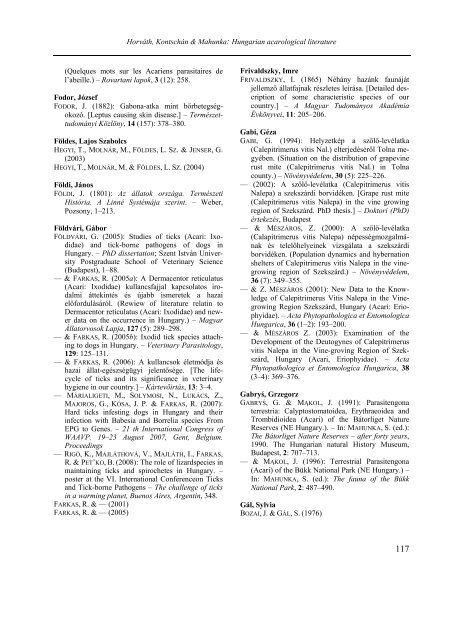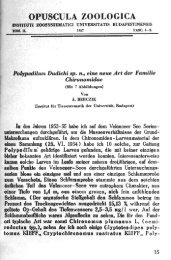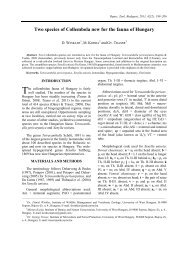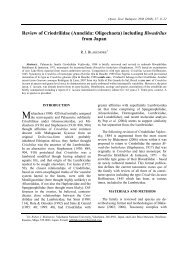1_ Acarol_lit.pdf - Opuscula Zoologica
1_ Acarol_lit.pdf - Opuscula Zoologica
1_ Acarol_lit.pdf - Opuscula Zoologica
You also want an ePaper? Increase the reach of your titles
YUMPU automatically turns print PDFs into web optimized ePapers that Google loves.
Horváth, Kontschán & Mahunka: Hungarian acarological <strong>lit</strong>erature<br />
(Quelques mots sur les Acariens parasitaires de<br />
l’abeille.) – Rovartani lapok, 3 (12): 258.<br />
Fodor, József<br />
FODOR, J. (1882): Gabona-atka mint bőrbetegségokozó.<br />
[Leptus causing skin disease.] – Természettudományi<br />
Közlöny, 14 (157): 378–380.<br />
Földes, Lajos Szabolcs<br />
HEGYI, T., MOLNÁR, M., FÖLDES, L. SZ. & JENSER, G.<br />
(2003)<br />
HEGYI, T., MOLNÁR, M. & FÖLDES, L. SZ. (2004)<br />
Földi, János<br />
FÖLDI, J. (1801): Az állatok országa. Természeti<br />
História. A Linné Systémája szerint. – Weber,<br />
Pozsony, 1–213.<br />
Földvári, Gábor<br />
FÖLDVÁRI, G. (2005): Studies of ticks (Acari: Ixodidae)<br />
and tick-borne pathogens of dogs in<br />
Hungary. – PhD dissertation; Szent István University<br />
Postgraduate School of Veterinary Science<br />
(Budapest), 1–88.<br />
— & FARKAS, R. (2005a): A Dermacentor reticulatus<br />
(Acari: Ixodidae) kullancsfajjal kapcsolatos irodalmi<br />
áttekintés és újabb ismeretek a hazai<br />
előfordulásáról. (Rewiew of <strong>lit</strong>erature relatin to<br />
Dermacentor reticulatus (Acari: Ixodidae) and newer<br />
data on the occurrence in Hungary.) – Magyar<br />
Állatorvosok Lapja, 127 (5): 289–298.<br />
— & FARKAS, R. (2005b): Ixodid tick species attaching<br />
to dogs in Hungary. – Veterinary Parasitology,<br />
129: 125–131.<br />
— & FARKAS, R. (2006): A kullancsok életmódja és<br />
hazai állat-egészségügyi jelentősége. [The lifecycle<br />
of ticks and its significance in veterinary<br />
hygiene in our country.] – Kártevőirtás, 13: 3–4.<br />
— MÁRIALIGETI, M., SOLYMOSI, N., LUKÁCS, Z.,<br />
MAJOROS, G., KÓSA, J. P. & FARKAS, R. (2007):<br />
Hard ticks infesting dogs in Hungary and their<br />
infection with Babesia and Borrelia species From<br />
EPG to Genes. – 21 th International Congress of<br />
WAAVP. 19–23 August 2007, Gent, Belgium.<br />
Proceedings<br />
— RIGÓ, K., MAJLÁTHOVÁ, V., MAJLÁTH, I., FARKAS,<br />
R. & PET’KO, B. (2008): The role of lizardspecies in<br />
maintaining ticks and spirochetes in Hungary. –<br />
poster at the VI. International Conferenceon Ticks<br />
and Tick-borne Pathogens – The challenge of ticks<br />
in a warming planet, Buenos Aires, Argentín, 348.<br />
FARKAS, R. & — (2001)<br />
FARKAS, R. & — (2005)<br />
Frivaldszky, Imre<br />
FRIVALDSZKY, I. (1865) Néhány hazánk faunáját<br />
jellemző állatfajnak részletes leírása. [Detailed description<br />
of some characteristic species of our<br />
country.] – A Magyar Tudományos Akadémia<br />
Évkönyvei, 11: 205–206.<br />
Gabi, Géza<br />
GABI, G. (1994): Helyzetkép a szőlő-levélatka<br />
(Calepitrimerus vitis Nal.) elterjedéséről Tolna megyében.<br />
(Situation on the distribution of grapevine<br />
rust mite (Calepitrimerus vitis Nal.) in Tolna<br />
county.) – Növényvédelem, 30 (5): 225–226.<br />
— (2002): A szőlő-levélatka (Calepitrimerus vitis<br />
Nalepa) a szekszárdi borvidéken. [Grape rust mite<br />
(Calepitrimerus vitis Nalepa) in the vine growing<br />
region of Szekszárd. PhD thesis.] – Doktori (PhD)<br />
értekezés, Budapest<br />
— & MÉSZÁROS, Z. (2000): A szőlő-levélatka<br />
(Calapitrimerus vitis Nalepa) népességmozgalmának<br />
és telelőhelyeinek vizsgálata a szekszárdi<br />
borvidéken. (Population dynamics and hybernation<br />
shelters of Calepitrimerus vitis Nalepa in the vinegrowing<br />
region of Szekszárd.) – Növényvédelem,<br />
36 (7): 349–355.<br />
— & Z. MÉSZÁROS (2001): New Data to the Knowledge<br />
of Calepitrimerus Vitis Nalepa in the Vinegrowing<br />
Region Szekszárd, Hungary (Acari: Eriophyidae).<br />
– Acta Phytopathologica et Entomologica<br />
Hungarica, 36 (1–2): 193–200.<br />
— & MÉSZÁROS Z. (2003): Examination of the<br />
Development of the Deutogynes of Calepitrimerus<br />
vitis Nalepa in the Vine-groving Region of Szekszárd,<br />
Hungary (Acari, Eriophyidae). – Acta<br />
Phytopathologica et Entomologica Hungarica, 38<br />
(3–4): 369–376.<br />
Gabryś, Grzegorz<br />
GABRYŚ, G. & MĄKOL, J. (1991): Parasitengona<br />
terrestria: Calyptostomatoidea, Erythraeoidea and<br />
Trombidioidea (Acari) of the Bátorliget Nature<br />
Reserves (NE Hungary.). – In: MAHUNKA, S. (ed.):<br />
The Bátorliget Nature Reserves – after forty years,<br />
1990. The Hungarian natural History Museum,<br />
Budapest, 2: 707–713.<br />
— & MĄKOL, J. (1996): Terrestrial Parasitengona<br />
(Acari) of the Bükk National Park (NE Hungary.) –<br />
In: MAHUNKA, S. (ed.): The fauna of the Bükk<br />
National Park, 2: 487–490.<br />
Gál, Sylvia<br />
BOZAI, J. & GÁL, S. (1976)<br />
117





